Call to Action: A Cholera-Free Hispaniola
Call to Action: A Cholera-Free Hispaniola
Moving from cholera control to cholera elimination through essential investments in water, sanitation, and hygiene infrastructure


In a press briefing, the governments of Haiti and the Dominican Republic, together with the Pan American Health Organization/World Health Organization (PAHO/WHO), the U.S. Centers for Disease Control and Prevention (CDC), UNICEF, and other key partners, launched a Call to Action for a Cholera-Free Hispaniola (Haiti and the Dominican Republic).
Video messages from the presidents of Dominican Republic and Haiti
…
Dr. Leonel Fernández Reyna, President of Dominican Republic:
…
SEM Michel Joseph Martelly, President of the Republic of Haiti:
…

Presentations:
Dr. Mirta Roses: Cholera in Latin America Lessons from history
Dr. Kevin De Cock: Elimination of Cholera in Haiti and the Dominican Republic
Sanjay Wijesekera: Complimentary actions needed beyond infrastructure in the water and sanitation sector Call (UNICEF)
Speeches:
In French: SEM Michel Joseph Martelly, President of the Republic of Haiti. 11 janvier 2012
In English: Speech His Excellency Michel Joseph Martelly President of the Republic of Haiti, 11 January 2012
In Spanish: Discurso Excelentísimo Señor Michel Joseph Martelly Presidente de la República de Haití, 11 de enero 2012
In French: Message du Président constitutionnel de la République dominicaine Docteur Leonel Fernández, 11 janvier 2012
In English: Message from the Constitutional President of the Dominican Republic Dr. Leonel Fernández, 11 January 2012
In Spanish: Mensaje del Señor Presidente Constitucional de la República Dominicana Doctor Leonel Fernández 11 de enero de 2012
Position paper
Call to Action: A Cholera‐Free Hispaniola
Appel à l’action : une île d’Hispaniola sans choléra
Llamado a la acción: La Hispaniola sin cólera

Call to Action: A Cholera‐Free Hispaniola
Moving from cholera control to cholera elimination through essential investments in water, sanitation, and hygiene infrastructure
Current Status of Cholera in Hispaniola
One of the largest cholera epidemics in modern history began in the Center and Artibonite Departments of Haiti in October 2010, just 10 months after the devastating earthquake of January 2010. Within 1 month, cholera had spread throughout Haiti and cases were being reported by its neighbor in the Dominican Republic. As of December 25, 2011, Haiti has reported 522,335 cases, 281,440 hospitalizations, and 7,001 deaths,1 making this the largest cholera epidemic in the world in decades. In the Dominican Republic, 21,432 cases have been reported, with 363 deaths (152 laboratory confirmed).2
The 2‐year anniversary of the earthquake is a time for the international community to call a halt to cholera and focus on short and long‐term actions to help the people of Haiti and the Dominican Republic fight this scourge. Our goal is to ensure that cholera does not remain endemic in Hispaniola.
Prevention and Control of Cholera on Hispaniola
Over the past year, the Governments of Haiti and the Dominican Republic supported by the international community, put in place crucial prevention and control strategies to reduce the debilitating toll of cholera and save lives.3,4
These strategies include:
- • Coordination and engagement of partners
- • Improving surveillance, early warning to monitor the spread of disease and determine actions
- • Improving access to safe drinking water via chlorinating water at the source and in the home, schools and other key locations.
- • Promoting safe hygiene and other public health preventive practices
- • Encouraging safe food handling practices and policies
- • Improving safe management of excreta and solid waste
- • Clarifying a role for oral cholera vaccines through vaccine pilot projects
- • Ensuring quality clinical care and treatment at health facility and community levels
- • Informing, mobilizing and engaging the community
These life‐saving interventions must be sustained and strengthened, embracing integrated prevention and control strategies through primary health and preventive care. For example, in the Dominican Republic, response strategies improved access to safe water and were combined with social mobilization and education to improve conditions in vulnerable areas.
To eliminate cholera from the Island of Hispaniola, we must urgently increase access to improved water and sanitation in Haiti, aiming to reach regional levels of coverage in Latin America and the Caribbean, as part of an integrated approach to the control of diarrhea. Controlling cholera in Hispaniola over the long‐term will be only possible through investments in water, sanitation, and hygiene infrastructure and by developing the institutional capacity to operate and maintain that infrastructure.
Current Water, Sanitation and Hygiene Conditions in Haiti and Dominican Republic
Haiti is by far the most underserved country in the Western Hemisphere in terms of water and sanitation infrastructure.5 Before the devastating earthquake of 2010, 63% of the 10 million residents in Haiti had access to an improved drinking water source (e.g., piped water into dwelling or yard, public standpipe, tubewell or borehole, protected dug well). Access to an improved sanitation facility (e.g., a flush toilet, piped sewer system, septic tank, ventilated improved pit latrine, composting toilet) in Haiti is significantly lower and actually declined from 26% of the total population in 1990 to 17% in 2008. Access to improved sanitation in rural areas is low at 10%, but coverage in urban areas is also strikingly low at 24%. Port au Prince, where more than 2 million people live, is one of the largest cities in the world with no municipal sewage system.
Water and sanitation figures for Haiti are much lower than the regional averages for Latin America and the Caribbean, and place Haiti among the lowest 12 countries worldwide in terms of sanitation coverage, according to data from the 2010 WHO/UNICEF Joint Monitoring Programme (JMP) for Water Supply and Sanitation. In addition, Haiti is one of the few countries in the world where overall coverage for sanitation has declined during the Millennium Development Goal campaign for reasons other than simple population growth.
Improved Water and Sanitation Coverage in Haiti and Dominican Republic vs. Regional Averages
Indicator /2008 — Haiti / Dominican Republic/ Latin America and Caribbean
Water — 63% /86% /93%
Sanitation — 17% (was 26% in 1990)/ 83% /80%
Elimination of Cholera from Latin American Countries (LAC): Lessons Learned
During the Latin America epidemic of the 1990s, cholera spread to over 20 countries in the first 2 years. Aggressive investment by the international community in water and sanitation infrastructure and health promotion resulted in improvements to drinking water quality, and rapidly expanded access to safe drinking water and sanitation. These actions contributed to the virtual elimination of epidemic cholera from Central and South America within 8 years,6‐7 by which time the epidemic had caused some 10,000 deaths and over 1 million cases of cholera. These increases in water and sanitation coverage, along with strong political commitment, resources, and development of surveillance systems to detect and monitor disease, helped to stem the cholera epidemic in Latin America. These efforts also led to well‐documented decreases in other waterborne diseases, such as typhoid fever and Hepatitis A in some countries, and dramatic improvements in infant and child mortality.7‐8 Most importantly, epidemic cholera has not recurred in Latin America after these gains were made.
A way forward for Hispaniola: Investing in Water, Sanitation, and Hygiene
The current water, sanitation, and hygiene situation in Haiti is the result of decades of neglect and underinvestment. We have an exciting opportunity to reverse that failure. This will take a long term, sustained commitment, and large scale investments from multiple partners. To control the current cholera epidemic and prevent recurrence, we must continue WASH investments with emphasis on long term infrastructure and increased capacity within Haiti to operate and maintain that infrastructure.
The needs are well‐known and not inexpensive, but are essential to avoid disease.9 Estimated rough costs from the Inter‐American Development Bank (IADB), the Office of the Haitian Prime Minister in Haiti, and the World Bank have ranged from $746 million to $1.1 billion.10‐11
In March 2010, the international community pledged billions to assist Haiti in post‐earthquake reconstruction,12 with major WASH projects underway in strengthening municipal water supplies, providing water and sanitation for displaced populations and in health facilities, improving water quality control, purchasing WASH commodities, and providing health worker training. The United States set committed more than $3 billion in humanitarian relief, recovery and reconstruction assistance. IADB has also committed $65 million in funding to expand water and sanitation coverage since the earthquake. However, other partners are needed to address the funding gap for water and sanitation infrastructure. In addition, Haiti’s water and sanitation agency, DINEPA, also developed a strategic plan in response to cholera that focused on household and community water chlorination, sanitation, hygiene and health education.
Significant commitments to water, sanitation and hygiene projects in Haiti have been made by nongovernmental organizations, although most of these investments have gone toward short‐term measures such as water trucking to temporary, make‐shift settlements set up after the earthquake. Additional projects are also underway, such as improving small‐scale water supplies, expanding coverage with household latrines, and improving water and sanitation supplies in health facilities. These activities are slowly improving the water and sanitation situation, especially in Port‐au‐Prince. In Dominican Republic as well, significant efforts have been done to reduce the impact of the cholera outbreak in Haiti over this country, such as sectoral coordination, communication and community mobilization, and sanitation and hygiene interventions at the community and school level, among others.
PAHO, CDC and UNICEF believe there are four key processes that must happen:
- • Improve water, sanitation, and hygiene infrastructure as a priority for governments and the international community. This event is the first part of an international dialogue that must continue to build support and political will for this investment.
- • Create a task force for water, sanitation, and hygiene infrastructure. With leadership by the Dominican Republic and Haitian governments, we encourage a key group of international water and sanitation experts from governments, NGOs, and private foundations to discuss and develop a detailed infrastructure plan for both Haiti and Dominican Republic.
- • Develop a detailed plan and timeline for water, sanitation, and hygiene infrastructure. An integrated strategy should be produced by Haitian and Dominican Republic Governments, with assistance from the task force. This should be based on a detailed analysis of existing infrastructure, identifying geographical and sectorial priorities for WASH investments. Along with infrastructure, this plan should take into account complimentary WASH interventions including behavioral changes and community mobilization efforts. A detailed implementation plan and timeline should follow this, with existing commitments for water and sanitation investments to be reviewed in the context of this plan.
- • Honor pledged post‐earthquake funds and recruit new partners. The international community has pledged billions in post‐earthquake reconstruction.12 Allotting a significant proportion of pledged funds to meet critical needs in water, sanitation, and hygiene represents an essential investment in the future of both the Dominican Republic and Haiti.
With collaboration from partners and use of funds already pledged, we can make an incredible difference in saving more lives and reducing disease well into the future.
References:
1. Ministère de Santé Publique et de la Population. Rapports journaliers du MSPP sur l’évolution ducholera en Haiti. 2010 [cited 2011 December 29].
2. Ministry of Public Health of the Dominican Republic. Weekly epidemiological bulletin number 51, 24December, 2011 [in Spanish] [cited 2011 December 29].
3. Tappero JW, Tauxe RV. Lessons learned during public health response to cholera epidemic in Haiti and the Dominican Republic. Emerg Infect Dis. 2011;17:2087‐2093.
4. Ivers LC, Farmer P, Almazor CP, Leandre F. Five complimentary interventions to slow cholera: Haiti. Lancet. 2010;376:2048‐51. Doi:10.1016/S0140‐6736(10)62243‐X
5. World Health Organization/UNICEF. 2010. Progress on sanitation and drinking‐water: 2010 update. Geneva: World Health Organization; 2010.
6. Sepulveda J, Valdespino JL, García‐García L. Cholera in Mexico: The paradoxical benefits of the last pandemic. Intl J Infect Dis 2006;10:4‐13.
7. Gaffga NH, Tauxe RV, Mintz ED. Cholera: a new homeland in Africa? Am J Trop Med Hyg 2007;77(4):705‐713.
8. Gutiérrez G, Tapia‐Conyer R, Guiscafré H, Reyes H, Martinez H, Kumate J. Impact of oral rehydration and selected public health interventions on reduction of mortality from childhood diarrhoeal diseases in Mexico. Bull World Health Org. 1996;74(2):189‐197.
9. Hutton G, Haller G, Bartram J. Estimating the costs and health benefits of water and sanitation improvements at global level. J Water Health 2007;05.4:467‐480.
10. Inter‐American Development Bank, Water and Sanitation Initiative. Drinking Water, Sanitation, and the Millennium Development Goals in Latin America and the Caribbean. Washington: The Bank; 2010.
11. Haiti earthquake PDNA: Assessment of damage, losses, general and sectoral needs. Annex to the action plan for national recovery and development of Haiti. Office of the Prime Minister. March 2010.
12. Haiti Country Strategy Update. [cited 2011 December 22]. http://idbdocs.iadb.org/wsdocs/getdocument.aspx?docnum=35285026

…
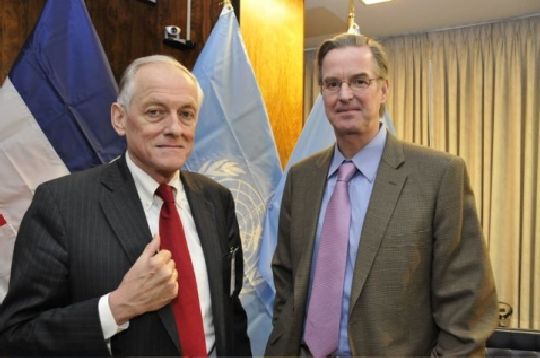
…
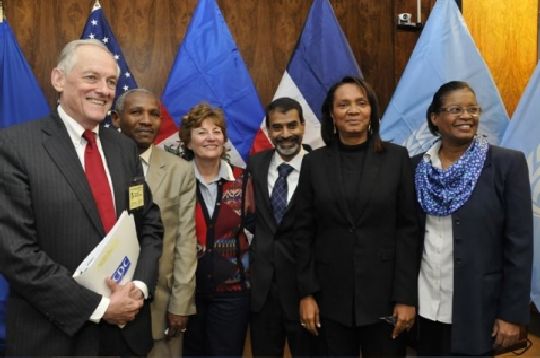
…
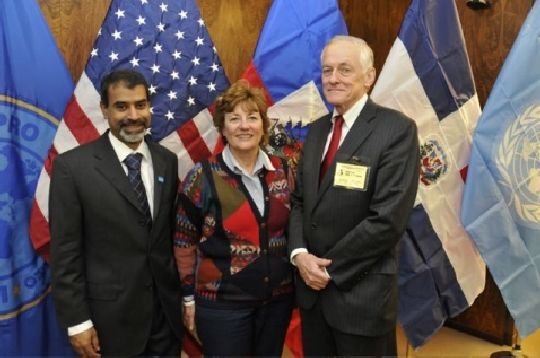
…
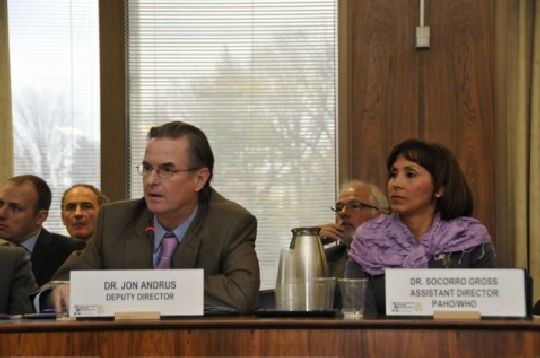
…

…
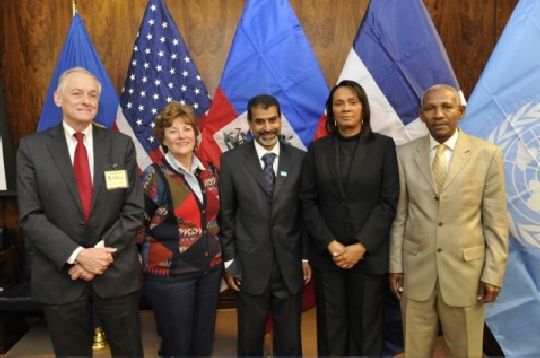
…
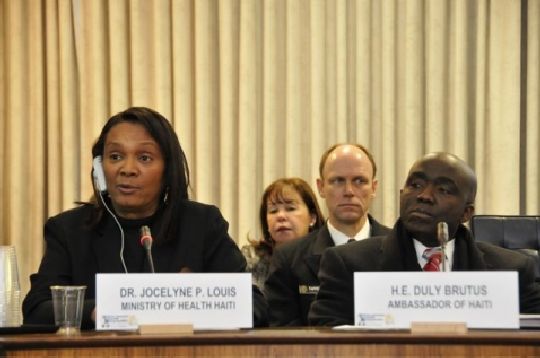
…
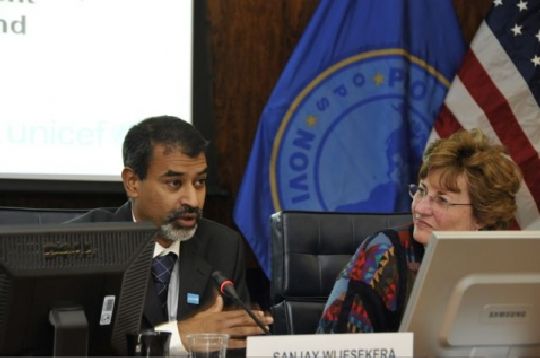
…

…

…
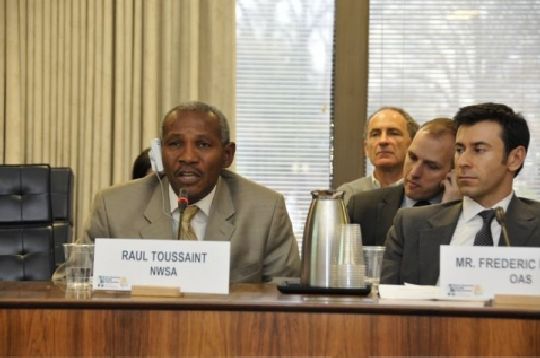
…
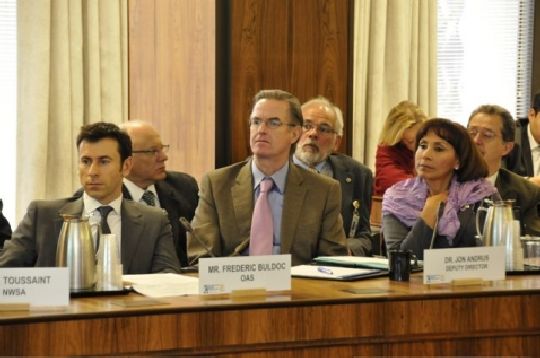
…
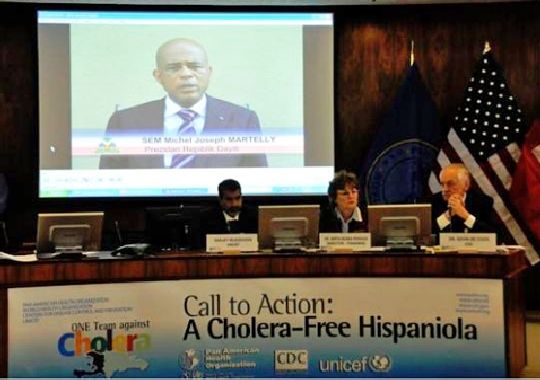
…
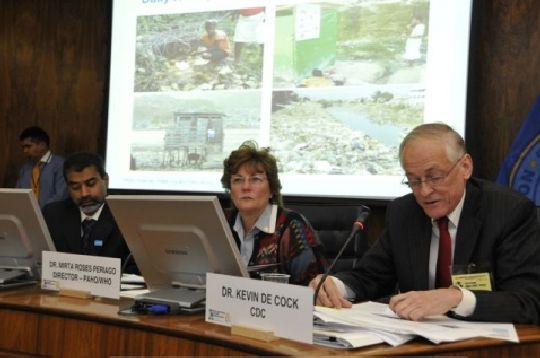
…

…

###
About World Health Organization (WHO)
WHO is the directing and coordinating authority for health within the United Nations system. It is responsible for providing leadership on global health matters, shaping the health research agenda, setting norms and standards, articulating evidence-based policy options, providing technical support to countries and monitoring and assessing health trends.
In the 21st century, health is a shared responsibility, involving equitable access to essential care and collective defence against transnational threats.
WHO fulfils its objectives through its core functions:
- providing leadership on matters critical to health and engaging in partnerships where joint action is needed;
- shaping the research agenda and stimulating the generation, translation and dissemination of valuable knowledge;
- setting norms and standards and promoting and monitoring their implementation;
- articulating ethical and evidence-based policy options;
- providing technical support, catalysing change, and building sustainable institutional capacity
- monitoring the health situation and assessing health trends.
The WHO agenda
WHO operates in an increasingly complex and rapidly changing landscape. The boundaries of public health action have become blurred, extending into other sectors that influence health opportunities and outcomes. WHO responds to these challenges using a six-point agenda. The six points address two health objectives, two strategic needs, and two operational approaches. The overall performance of WHO will be measured by the impact of its work on women’s health and health in Africa.
1. Promoting development
During the past decade, health has achieved unprecedented prominence as a key driver of socioeconomic progress, and more resources than ever are being invested in health. Yet poverty continues to contribute to poor health, and poor health anchors large populations in poverty. Health development is directed by the ethical principle of equity: Access to life-saving or health-promoting interventions should not be denied for unfair reasons, including those with economic or social roots. Commitment to this principle ensures that WHO activities aimed at health development give priority to health outcomes in poor, disadvantaged or vulnerable groups. Attainment of the health-related Millennium Development Goals, preventing and treating chronic diseases and addressing the neglected tropical diseases are the cornerstones of the health and development agenda.
2. Fostering health security
Shared vulnerability to health security threats demands collective action. One of the greatest threats to international health security arises from outbreaks of emerging and epidemic-prone diseases. Such outbreaks are occurring in increasing numbers, fuelled by such factors as rapid urbanization, environmental mismanagement, the way food is produced and traded, and the way antibiotics are used and misused. The world’s ability to defend itself collectively against outbreaks has been strengthened since June 2007, when the revised International Health Regulations came into force.
3. Strengthening health systems
For health improvement to operate as a poverty-reduction strategy, health services must reach poor and underserved populations. Health systems in many parts of the world are unable to do so, making the strengthening of health systems a high priority for WHO. Areas being addressed include the provision of adequate numbers of appropriately trained staff, sufficient financing, suitable systems for collecting vital statistics, and access to appropriate technology including essential drugs.
4. Harnessing research, information and evidence
Evidence provides the foundation for setting priorities, defining strategies, and measuring results. WHO generates authoritative health information, in consultation with leading experts, to set norms and standards, articulate evidence-based policy options and monitor the evolving global heath situation.
5. Enhancing partnerships
WHO carries out its work with the support and collaboration of many partners, including UN agencies and other international organizations, donors, civil society and the private sector. WHO uses the strategic power of evidence to encourage partners implementing programmes within countries to align their activities with best technical guidelines and practices, as well as with the priorities established by countries.
6. Improving performance
WHO participates in ongoing reforms aimed at improving its efficiency and effectiveness, both at the international level and within countries. WHO aims to ensure that its strongest asset – its staff – works in an environment that is motivating and rewarding. WHO plans its budget and activities through results-based management, with clear expected results to measure performance at country, regional and international levels.
###
About United Nations Children’s Fund (UNICEF)

UNICEF works in 190 countries and territories to help children survive and thrive, from early childhood through adolescence. The world’s largest provider of vaccines for developing countries, UNICEF supports child health and nutrition, good water and sanitation, quality basic education for all boys and girls, and the protection of children from violence, exploitation, and AIDS. UNICEF is funded entirely by the voluntary contributions of individuals, businesses, foundations and governments. For more information about UNICEF and its work visit: www.unicef.org
###
> United Nations (UN).
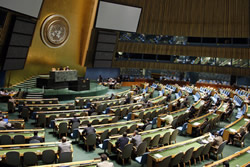 The United Nations was established on 24 October 1945 by 51 countries committed to preserving peace through international cooperation and collective security. Today, nearly every nation in the world belongs to the UN: membership totals 192 countries.
The United Nations was established on 24 October 1945 by 51 countries committed to preserving peace through international cooperation and collective security. Today, nearly every nation in the world belongs to the UN: membership totals 192 countries.
When States become Members of the United Nations, they agree to accept the obligations of the UN Charter, an international treaty that sets out basic principles of international relations. According to the Charter, the UN has four purposes:
- to maintain international peace and security;
- to develop friendly relations among nations;
- to cooperate in solving international problems and in promoting respect for human rights;
- and to be a centre for harmonizing the actions of nations.
###
* The above story is adapted from materials provided by United Nations (UN)
** More information at United Nations (UN)




















